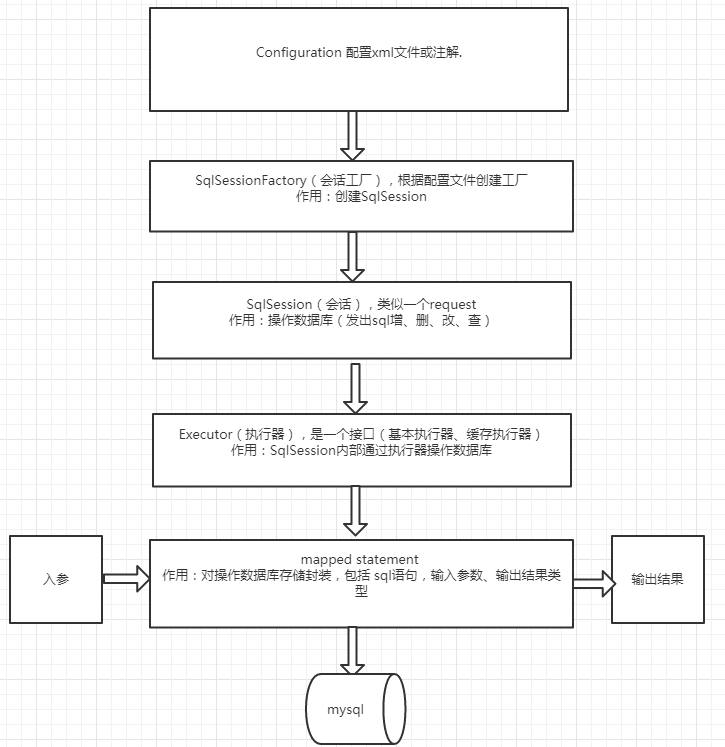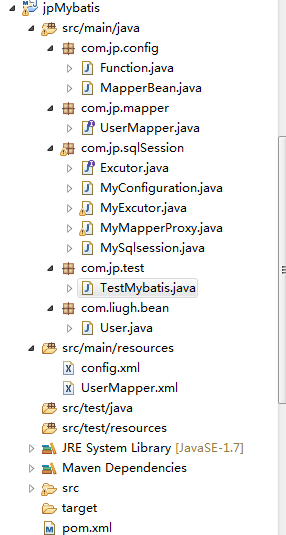自己实现一个简化版Mybatis框架
MyBatis框架的核心功能其实不难,无非就是动态代理和jdbc的操作,难的是写出来可扩展,高内聚,低耦合的规范的代码。本文完成的Mybatis功能比较简单,代码还有许多需要改进的地方,大家可以结合Mybatis源码去动手完善。
一、Mybatis框架流程简介

在手写自己的Mybatis框架之前,我们先来了解一下Mybatis,它的源码中使用了大量的设计模式,阅读源码并观察设计模式在其中的应用,才能够更深入的理解源码(ref:Mybatis源码解读-设计模式总结)。我们对上图进行分析总结:
- mybatis的配置文件有2类
- mybatisconfig.xml,配置文件的名称不是固定的,配置了全局的参数的配置,全局只能有一个配置文件。
- Mapper.xml 配置多个statemement,也就是多个sql,整个mybatis框架中可以有多个Mappe.xml配置文件。
- 通过mybatis配置文件得到SqlSessionFactory
- 通过SqlSessionFactory得到SqlSession,用SqlSession就可以操作数据了。
- SqlSession通过底层的Executor(执行器),执行器有2类实现:

基本实现
带有缓存功能的实现
5.MappedStatement是通过Mapper.xml中定义statement生成的对象。
6.参数输入执行并输出结果集,无需手动判断参数类型和参数下标位置,且自动将结果集映射为Java对象
- HashMap,KV格式的数据类型
- Java的基本数据类型
- POJO,java的对象
二、梳理自己的Mybatis的设计思路
根据上文Mybatis流程,我简化了下,分为以下步骤:

1.读取xml文件,建立连接
从图中可以看出,MyConfiguration负责与人交互。待读取xml后,将属性和连接数据库的操作封装在MyConfiguration对象中供后面的组件调用。本文将使用dom4j来读取xml文件,它具有性能优异和非常方便使用的特点。
2.创建SqlSession,搭建Configuration和Executor之间的桥梁
我们经常在使用框架时看到Session,Session到底是什么呢?一个Session仅拥有一个对应的数据库连接。类似于一个前段请求Request,它可以直接调用exec(SQL)来执行SQL语句。从流程图中的箭头可以看出,MySqlSession的成员变量中必须得有MyExecutor和MyConfiguration去集中做调配,箭头就像是一种关联关系。我们自己的MySqlSession将有一个getMapper方法,然后使用动态代理生成对象后,就可以做数据库的操作了。
3.创建Executor,封装JDBC操作数据库
Executor是一个执行器,负责SQL语句的生成和查询缓存(缓存还没完成)的维护,也就是jdbc的代码将在这里完成,不过本文只实现了单表,有兴趣的同学可以尝试完成多表。
4.创建MapperProxy,使用动态代理生成Mapper对象
我们只是希望对指定的接口生成一个对象,使得执行它的时候能运行一句sql罢了,而接口无法直接调用方法,所以这里使用动态代理生成对象,在执行时还是回到MySqlSession中调用查询,最终由MyExecutor做JDBC查询。这样设计是为了单一职责,可扩展性更强。
三、实现自己的Mybatis
工程文件及目录:

3.1 创建maven项目配置数据源
首先,新建一个maven项目,在pom.xml中导入以下依赖:
<project xmlns="http://maven.apache.org/POM/4.0.0" xmlns:xsi="http://www.w3.org/2001/XMLSchema-instance" xsi:schemaLocation="http://maven.apache.org/POM/4.0.0 http://maven.apache.org/xsd/maven-4.0.0.xsd">
<modelVersion>4.0.0</modelVersion>
<groupId>com.liugh</groupId>
<artifactId>jpMybatis</artifactId>
<version>0.0.1-SNAPSHOT</version>
<packaging>jar</packaging> <properties>
<project.build.sourceEncoding>UTF-8</project.build.sourceEncoding>
<maven.compiler.source>1.8</maven.compiler.source>
<maven.compiler.target>1.8</maven.compiler.target>
<java.version>1.8</java.version>
</properties> <dependencies>
<!-- 读取xml文件 -->
<dependency>
<groupId>dom4j</groupId>
<artifactId>dom4j</artifactId>
<version>1.6.1</version>
</dependency> <!-- MySQL -->
<dependency>
<groupId>mysql</groupId>
<artifactId>mysql-connector-java</artifactId>
<version>5.1.29</version>
</dependency>
</dependencies>
</project>
创建我们的数据库xml配置文件:
<?xml version="1.0" encoding="UTF-8"?>
<database>
<property name="driverClassName">com.mysql.jdbc.Driver</property>
<property name="url">jdbc:mysql://localhost:3306/test?useUnicode=true&characterEncoding=utf8</property>
<property name="username">root</property>
<property name="password">123456</property>
</database>
然后在数据库创建test库,执行如下SQL语句:
CREATE TABLE `user` (
`id` varchar(64) NOT NULL,
`password` varchar(255) DEFAULT NULL,
`username` varchar(255) DEFAULT NULL,
PRIMARY KEY (`id`)
) ENGINE=InnoDB AUTO_INCREMENT=2 DEFAULT CHARSET=utf8;
INSERT INTO `test`.`user` (`id`, `password`, `username`) VALUES ('', '', 'wjp');
3.2 创建User实体类,和UserMapper接口和对应的xml文件
package com.jp.bean;
public class User {
private String id;
private String username;
private String password;
//省略get set toString方法...
}
package com.jp.mapper;
import com.jp.bean.User;
public interface UserMapper {
public User getUserById(String id);
}
<?xml version="1.0" encoding="UTF-8"?>
<mapper nameSpace="com.liugh.mapper.UserMapper">
<select id="getUserById" resultType ="com.liugh.bean.User">
select * from user where id = ?
</select>
</mapper>
3.3 基本操作配置完成,接下来我们开始实现MyConfiguration:
先准备封装我们读取xml配置信息的 类,即用面向对象的思想设计读取xml配置
package com.jp.config; import java.util.List;
public class MapperBean {
private String interfaceName; //接口名
private List<Function> list; //接口下所有方法
//省略 get set方法...
}
Function对象包括sql的类型、方法名、sql语句、返回类型和参数类型。
package com.jp.config;
public class Function {
private String sqltype;
private String funcName;
private String sql;
private Object resultType;
private String parameterType;
//省略 get set方法
}
我们实现MyConfiguration,读取并存储配置信息,建立连接
package com.jp.sqlSession; import java.io.InputStream;
import java.sql.Connection;
import java.sql.DriverManager;
import java.sql.SQLException;
import java.util.ArrayList;
import java.util.Iterator;
import java.util.List;
import org.dom4j.Document;
import org.dom4j.DocumentException;
import org.dom4j.Element;
import org.dom4j.io.SAXReader;
import com.jp.config.Function;
import com.jp.config.MapperBean; /**
* 读取与解析配置信息,并返回处理后的Environment
*/
public class MyConfiguration {
private static ClassLoader loader = ClassLoader.getSystemClassLoader(); /**
* 读取数据库配置信息(config.xml信息)并建立连接connection
*
*/
public Connection build(String resource){
try {
InputStream stream = loader.getResourceAsStream(resource);
SAXReader reader = new SAXReader();
Document document = reader.read(stream);
Element root = document.getRootElement();
return evalDataSource(root);
} catch (Exception e) {
throw new RuntimeException("error occured while evaling xml " + resource);
}
} private Connection evalDataSource(Element node) throws ClassNotFoundException {
if (!node.getName().equals("database")) {
throw new RuntimeException("root should be <database>");
}
String driverClassName = null;
String url = null;
String username = null;
String password = null;
//获取属性节点
for (Object item : node.elements("property")) {
Element i = (Element) item;
String value = getValue(i);
String name = i.attributeValue("name");
if (name == null || value == null) {
throw new RuntimeException("[database]: <property> should contain name and value");
}
//赋值
switch (name) {
case "url" : url = value; break;
case "username" : username = value; break;
case "password" : password = value; break;
case "driverClassName" : driverClassName = value; break;
default : throw new RuntimeException("[database]: <property> unknown name");
}
} Class.forName(driverClassName);
Connection connection = null;
try {
//建立数据库链接
connection = DriverManager.getConnection(url, username, password);
} catch (SQLException e) {
// TODO Auto-generated catch block
e.printStackTrace();
}
return connection;
} //获取property属性的值,如果有value值,则读取 没有设置value,则读取内容
private String getValue(Element node) {
return node.hasContent() ? node.getText() : node.attributeValue("value");
} /**
*
* @param path
* @return
*/
@SuppressWarnings("rawtypes")
public MapperBean readMapper(String path){
MapperBean mapper = new MapperBean();
try{
InputStream stream = loader.getResourceAsStream(path);
SAXReader reader = new SAXReader();
Document document = reader.read(stream);
Element root = document.getRootElement();
mapper.setInterfaceName(root.attributeValue("nameSpace").trim()); //把mapper节点的nameSpace值存为接口名
List<Function> list = new ArrayList<Function>(); //用来存储方法的List
for(Iterator rootIter = root.elementIterator();rootIter.hasNext();) {//遍历根节点下所有子节点
Function fun = new Function(); //用来存储一条方法的信息
Element e = (Element) rootIter.next();
String sqltype = e.getName().trim();
String funcName = e.attributeValue("id").trim();
String sql = e.getText().trim();
String resultType = e.attributeValue("resultType").trim();
fun.setSqltype(sqltype);
fun.setFuncName(funcName);
Object newInstance=null;
try {
newInstance = Class.forName(resultType).newInstance();
} catch (InstantiationException e1) {
e1.printStackTrace();
} catch (IllegalAccessException e1) {
e1.printStackTrace();
} catch (ClassNotFoundException e1) {
e1.printStackTrace();
}
fun.setResultType(newInstance);
fun.setSql(sql);
list.add(fun);
}
mapper.setList(list); } catch (DocumentException e) {
e.printStackTrace();
}
return mapper;
}
}
3.4 实现我们的MySqlSession
首先的成员变量里得有Excutor和MyConfiguration,代码的精髓就在getMapper的方法里。
package com.jp.sqlSession;
import java.lang.reflect.Proxy;
public class MySqlsession {
private Excutor excutor = new MyExcutor();
private MyConfiguration myConfiguration = new MyConfiguration();
public <T> T selectOne(String statement, Object parameter) {
return excutor.query(statement, parameter);
}
@SuppressWarnings("unchecked")
public <T> T getMapper(Class<T> clas) {
// 动态代理调用
return (T) Proxy.newProxyInstance(clas.getClassLoader(), new Class[] { clas },
new MyMapperProxy(myConfiguration, this));
}
}
紧接着创建Excutor和实现类:
package com.jp.sqlSession;
public interface Excutor {
public <T> T query(String statement,Object parameter);
}
MyExcutor中封装了JDBC的操作:
package com.jp.sqlSession; import java.sql.Connection;
import java.sql.PreparedStatement;
import java.sql.ResultSet;
import java.sql.SQLException;
import com.jp.bean.User; public class MyExcutor implements Excutor { private MyConfiguration xmlConfiguration = new MyConfiguration(); @Override
public <T> T query(String sql, Object parameter) {
Connection connection = getConnection();
ResultSet set = null;
PreparedStatement pre = null;
try {
pre = connection.prepareStatement(sql);
// 设置参数
pre.setString(1, parameter.toString());
set = pre.executeQuery();
User u = new User();
// 遍历结果集
while (set.next()) {
u.setId(set.getString(1));
u.setUsername(set.getString(2));
u.setPassword(set.getString(3));
}
return (T) u;
} catch (SQLException e) {
e.printStackTrace();
} finally {
try {
if (set != null) {
set.close();
}
if (pre != null) {
pre.close();
}
if (connection != null) {
connection.close();
}
} catch (Exception e2) {
e2.printStackTrace();
}
}
return null;
} //MyConfiguration类的build函数,创建的数据库连接
private Connection getConnection() {
try {
Connection connection = xmlConfiguration.build("config.xml");
return connection;
} catch (Exception e) {
e.printStackTrace();
}
return null;
}
}
MyMapperProxy代理类完成xml方法和真实方法对应,执行查询:
package com.jp.sqlSession; import java.lang.reflect.InvocationHandler;
import java.lang.reflect.Method;
import java.util.List;
import com.jp.config.Function;
import com.jp.config.MapperBean; public class MyMapperProxy implements InvocationHandler { private MySqlsession mySqlsession; private MyConfiguration myConfiguration; public MyMapperProxy(MyConfiguration myConfiguration, MySqlsession mySqlsession) {
this.myConfiguration = myConfiguration;
this.mySqlsession = mySqlsession;
} @Override
public Object invoke(Object proxy, Method method, Object[] args) throws Throwable {
MapperBean readMapper = myConfiguration.readMapper("UserMapper.xml");
// 是否是xml文件对应的接口
if (!method.getDeclaringClass().getName().equals(readMapper.getInterfaceName())) {
return null;
}
List<Function> list = readMapper.getList();
if (null != list || 0 != list.size()) {
for (Function function : list) {
// id是否和接口方法名一样
if (method.getName().equals(function.getFuncName())) {
return mySqlsession.selectOne(function.getSql(), String.valueOf(args[0]));
}
}
}
return null;
}
}
3.5 到这里,就完成了自己的Mybatis框架,我们测试一下:
package com.jp.test; import com.jp.mapper.UserMapper;
import com.jp.sqlSession.MySqlsession;
import com.jp.bean.User; public class TestMybatis { public static void main(String[] args) {
MySqlsession sqlsession=new MySqlsession();
UserMapper mapper = sqlsession.getMapper(UserMapper.class);
User user = mapper.getUserById("1");
System.out.println(user);
}
}

https://my.oschina.net/liughDevelop/blog/1631006
自己实现一个简化版Mybatis框架的更多相关文章
- 从 0 开始手写一个 Mybatis 框架,三步搞定!
阅读本文大概需要 3 分钟. MyBatis框架的核心功能其实不难,无非就是动态代理和jdbc的操作,难的是写出来可扩展,高内聚,低耦合的规范的代码. 本文完成的Mybatis功能比较简单,代码还有许 ...
- Spring+SpringMvc+Mybatis框架集成搭建教程
一.背景 最近有很多同学由于没有过SSM(Spring+SpringMvc+Mybatis , 以下简称SSM)框架的搭建的经历,所以在自己搭建SSM框架集成的时候,出现了这样或者那样的问题,很是苦恼 ...
- Mybatis框架中实现双向一对多关系映射
学习过Hibernate框架的伙伴们很容易就能简单的配置各种映射关系(Hibernate框架的映射关系在我的blogs中也有详细的讲解),但是在Mybatis框架中我们又如何去实现 一对多的关系映射呢 ...
- Hibernate框架与Mybatis框架的对比
学习了Hibernate和Mybatis,但是一直不太清楚他们两者的区别的联系,今天在网上翻了翻,就做了一下总结,希望对大家有帮助! 原文:http://blog.csdn.net/firejuly/ ...
- 初识Mybatis框架,实现增删改查等操作(动态拼接和动态修改)
此第一次接触Mybatis框架确实是有点不适应,特别是刚从Hibernate框架转转型过来,那么为什么要使用Mybatis框架,Mybatis框架和Hibernate框架又有什么异同呢? 这个问题在我 ...
- Spring+MyBatis框架中sql语句的书写,数据集的传递以及多表关联查询
在很多Java EE项目中,Spring+MyBatis框架经常被用到,项目搭建在这里不再赘述,现在要将的是如何在项目中书写,增删改查的语句,如何操作数据库,以及后台如何获取数据,如何进行关联查询,以 ...
- SSM框架-----------SpringMVC+Spring+Mybatis框架整合详细教程
1.基本概念 1.1.Spring Spring是一个开源框架,Spring是于2003 年兴起的一个轻量级的Java 开发框架,由Rod Johnson 在其著作Expert One-On-One ...
- Spring3.0 与 MyBatis框架 整合小实例
本文将在Eclipse开发环境下,采用Spring MVC + Spring + MyBatis + Maven + Log4J 框架搭建一个Java web 项目. 1. 环境准备: 1.1 创建数 ...
- 手把手Maven搭建SpringMVC+Spring+MyBatis框架(超级详细版)
手把手Maven搭建SpringMVC+Spring+MyBatis框架(超级详细版) SSM(Spring+SpringMVC+Mybatis),目前较为主流的企业级架构方案.标准的MVC设计模式, ...
随机推荐
- nginx环境准备
一.环境调试确认 1.四项确认 确认公网已连通. 确认yum源可用. 确认iptables已经关闭. 确认selinux已经关闭. a.确认是否连通公网. ping www.baidu.com b.确 ...
- Vue常见的框架
1. Element:一套为开发者,设计师和产品经理准备的基于Vue 2.0的桌面端组件库 地址:https://element.eleme.cn/#/zh-CN 2.iview:主要服务于PC界面的 ...
- 校验表单demo
<!DOCTYPE html PUBLIC "-//W3C//DTD XHTML 1.0 Transitional//EN" "http://www.w3.org/ ...
- 客户端服务器通讯常用的一种方法——Marshal类
这个类是.NETFramework2.0中的类,所以我们能够将其用于Unity中.与这个类类似的还有litjson等,可能是为了节省字节空间,Marshal类只仅仅将值进行打包成bytes流,而jso ...
- JavaScript 格式化数字成金额格式
在看公司一个项目的JavaScript代码时,发现一段JavaScript代码,是把数字格式化成金额格式 比如: 12345.678 格式化成 12,345.68 看完代码后,google了一下,发 ...
- c++ STL之unordered_set
unordered_set的特点: 自身值就是主键,所以值唯一并且不可修改 基于hash表的无序排列 unordered_set基于哈希表,是无序的. 在一个 unordered_set 容器中,元素 ...
- mingw32-gcc-9.2.1-i686-posix-sjlj-20190904-8ba5c53
gcc -v Using built-in specs. COLLECT_GCC=gcc COLLECT_LTO_WRAPPER=d:/msys/mingw32/bin/../libexec/gcc/ ...
- flask 之(六) --- API|RestfulApi
接口概念 IOP:面向接口编程,不再关注具体的实现:只关注输入.输出. http://www.ruanyifeng.com/blog/2018/10/restful-api-best-practice ...
- JAVA师徒架构班 - 带徒模式
(转: http://www.jeecg.org/forum.php?mod=viewthread&tid=2291&extra=page%3D1&page=1) 一个程序员技 ...
- Elasticsearch-如何识别一篇文档
ES-识别文档 为了识别同一个索引中的某篇文档,ES使用_uid中的文档类型和ID结合体._uid字段是由_id和_type字段组成,当搜索或者检索文档的时候总是能获得这两项信息. FengZhend ...
